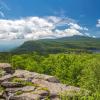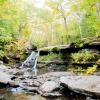Catskill Park






Park Overview:
Thirty-three peaks and ridges on public lands in the Catskills have elevations of 3,500 feet or more; 19 of them have maintained trails to their summits. Hundreds of miles of trails of all degrees of difficulty invite the hiker to this varied and delightful area.
Park Description:
|
Trail Alerts - Catskill Park Click here to find trail alerts and updates for the Catskills. |
Catskill Park
North of the more familiar metropolitan hiking areas are the Catskills, whose high summits and steep climbs can provide especially rewarding hiking. The paved roads through the mountains of Catskill Park are well populated with hotels, bed-and-breakfast establishments, and private homes, but the higher, more rugged and remote parts of these mountains are unspoiled. From the summits and other vantage points, the views are magnificent. To the east, the Hudson River valley is spread out against a backdrop of New England hills, and in all directions lie the fir-topped peaks of the Catskills themselves, with little or no sign of human intrusion.
Thirty-three peaks and ridges on public lands in the Catskills have elevations of 3,500 feet or more; 19 of them have maintained trails to their summits. Hunter and Slide Mountains reach 4,000 feet in elevation.
Hundreds of miles of trails of all degrees of difficulty invite the hiker to this varied and delightful area. Although a great deal of the forest land in the Catskills can be explored using marked trails, hikers can find out what the wilderness is really like only by "getting off the beaten path." Trailless travel, or bushwhacking, often leads to interesting discoveries - a little-known waterfall, a balanced rock, or one of the remains of the mountain industries of the last century. Best of all, bushwhacking heightens the hiker's awareness of the environment.
- Some of the trailless Catskill summits, such as Rocky or Balsam Cap, are thickly overgrown with spruce, making bushwhacking a physically demanding endeavor. Others, such as Halcott or Vly, are relatively open. All hikers - but especially those who plan to bushwhack - should let someone know where they are going before setting out, and their expected time of return.
Keep yourself informed about the latest Catskill news and trails opportunities by visiting the Catskill Trail News and Programs Page.
- Opened in 2015, the Catskill Interpretive Center is “… a place where residents and visitors can learn about [the] unique natural, historical, and cultural resources” of the region.
The Catskill Forest Preserve is comprised of state-owned lands within the "Blue Line" boundary of the Catskills region. The Preserve contains numerous wild forests, wilderness areas and campgrounds managed by the New York State Department of Environmental Conservation [DEC]. Many New York City watershed lands in the Catskills, managed by the NYCDEP, are open for hiking and boating. The Catskill Mountain Club provides a helpful overview with links to the NYCDEP site.
Trails Overview:
Catskill Park described on this page is not actually a single park but consists of public and private lands in the Catskills region open to hikers. This website subdivides the Catskills according to geographical location based on the Trail Conference “Catskill Trails” map set
- Catskills – Northeastern (TC Map 141)
- Escarpment Trail
- Devil's Path
- Hunter Mountain (current page to be revised)
- Spruceton Trail
- Overlook Mountain
- Kaaterskill Falls
- North/South Lake Area
- Catskills – Central (TC Maps 142, 145)
- Dry Brook Ridge Trail
- Mill Brook Ridge Trail (Balsam Lake Mountain)
- Pine Hill-West Branch Trail
- Giant Ledge-Panther-Fox Hollow Trail
- Panther Mountain
- Belleayre Mountain
- Catskills – Southern (TC Maps 143, 146)
- Wittenberg-Cornell-Slide Trail (a.k.a. Burroughs Range Trail)
- Peekamoose-Table Trail
- Slide Mountain (page to be revised)
- Catskills – Western (TC Map 144)
- Trout Pond

- Little Pond
- Mongaup Pond
- Trout Pond
Each of these provides a description of the sub-region, trails overview, and directions.
Trails in the Catskills are marked with the New York State Department of Environmental Conservation [DEC] plastic markers nailed to trees - blue for trails that run generally north-south, red for trails running east-west, and yellow for connecting trails or trails running diagonally.
Click to see a larger version of this map overview image.
The Long Path (aqua blaze) traverses the Catskill Park in a north-south direction for 94 miles,
Looking for a hike in the Catskills?
Park Acreage:
292000.00 acresMunicipality:
Various towns, Greene/Sullivan/DelawareThirty-three peaks and ridges on public lands in the Catskills have elevations of 3,500 feet or more; 19 of them have maintained trails to their summits. Hundreds of miles of trails of all degrees of difficulty invite the hiker to this varied and delightful area.
|
Trail Alerts - Catskill Park Click here to find trail alerts and updates for the Catskills. |
Catskill Park
North...
Park Acreage:
292000.00 acresMunicipality:
Various towns, Greene/Sullivan/DelawareContact Information
Web Link:
NYS, Department of Environmental ConservationPhone:
Not availableFees:
NoneDogs in park:
Dogs off leashHike Checklist:
Whether you are going for a day hike or backpacking overnight, it is good practice to carry what we call The Hiking Essentials. These essentials will help you enjoy your outing more and will provide basic safety gear if needed. There may also be more essentials, depending on the season and your needs.
The Essentials
Hiking Shoes or Boots
Water - Two quarts per person is recommended in every season. Keep in mind that fluid loss is heightened in winter as well as summer. Don't put yourself in the position of having to end your hike early because you have run out of water.
Map - Know where you are and where you are going. Many of our hiking areas feature interconnecting network of trails. Use a waterproof/tear-resistant Tyvek Trail Conference map if available or enclose your map in a Ziplock plastic bag. If you have a mobile device, download Avenza’s free PDF Maps app and grab some GPS-enhanced Trail Conference maps (a backup Tyvek or paper version of the map is good to have just in case your batteries die or you don't have service). Check out some map-reading basics here.
Food - Snacks/lunch will keep you going as you burn energy walking or climbing. Nuts, seeds, and chocolate are favorites on the trail.
Sunscreen and insect repellent
Rain Gear and Extra Clothing - Rain happens. So does cold. Be prepared for changing weather. Avoid cotton--it traps water against your skin and is slow to dry. If you are wearing wet cotton and must return to your starting point, you risk getting chills that may lead to a dangerous hypothermia. Choose synthetic shirts, sweaters and/or vests and dress in layers for easy on and off.
Compass - A simple compass is all you need to orient you and your map to magnetic north.
Light - A flashlight or small, lightweight headlamp will be welcome gear if you find yourself still on the trail when darkness falls. Check the batteries before you start out and have extras in your pack.
First Aid Kit - Keep it simple, compact, and weatherproof. Know how to use the basic components.
Firestarter and Matches - In an emergency, you may need to keep yourself or someone else warm until help arrives. A firestarter (this could be as simple as leftover birthday candles that are kept inside a waterproof container) and matches (again, make sure to keep them in a waterproof container) could save a life.
Knife or Multi-tool - You may need to cut a piece of moleskin to put over a blister, repair a piece of broken equipment, or solve some other unexpected problem.
Emergency Numbers - Know the emergency numbers for the area you're going to and realize that in many locations--especially mountainous ones, your phone will not get reception.
Common Sense - Pay attention to your environment, your energy, and the condition of your companions. Has the weather turned rainy? Is daylight fading? Did you drink all your water? Did your companion fail to bring rain gear? Are you getting tired? Keep in mind that until you turn around you are (typically) only half-way to completing your hike--you must still get back to where you started from! (Exceptions are loop hikes.)
Check the weather forecast before you head out. Know the rules and regulations of the area.
The Leave No Trace Seven Principles
Plan Ahead and Prepare
- Know the regulations and special concerns for the area you'll visit.
- Prepare for extreme weather, hazards, and emergencies.
- Schedule your trip to avoid times of high use.
- Visit in small groups when possible. Consider splitting larger groups into smaller groups.
- Repackage food to minimize waste.
- Use a map and compass to eliminate the use of marking paint, rock cairns or flagging.
Travel and Camp on Durable Surfaces
- Durable surfaces include established trails and campsites, rock, gravel, dry grasses or snow.
- Protect riparian areas by camping at least 200 feet from lakes and streams.
- Good campsites are found, not made. Altering a site is not necessary.
- In popular areas:
- Concentrate use on existing trails and campsites.
- Walk single file in the middle of the trail, even when wet or muddy.
- Keep campsites small. Focus activity in areas where vegetation is absent.
- In pristine areas:
- Disperse use to prevent the creation of campsites and trails.
- Avoid places where impacts are just beginning.
- Pack it in, pack it out. Inspect your campsite and rest areas for trash or spilled foods. Pack out all trash, leftover food and litter.
- Deposit solid human waste in catholes dug 6 to 8 inches deep, at least 200 feet from water, camp and trails. Cover and disguise the cathole when finished.
- Pack out toilet paper and hygiene products.
- To wash yourself or your dishes, carry water 200 feet away from streams or lakes and use small amounts of biodegradable soap. Scatter strained dishwater.
- Preserve the past: examine, but do not touch cultural or historic structures and artifacts.
- Leave rocks, plants and other natural objects as you find them.
- Avoid introducing or transporting non-native species.
- Do not build structures, furniture, or dig trenches.
- Campfires can cause lasting impacts to the backcountry. Use a lightweight stove for cooking and enjoy a candle lantern for light.
- Where fires are permitted, use established fire rings, fire pans, or mound fires.
- Keep fires small. Only use sticks from the ground that can be broken by hand.
- Burn all wood and coals to ash, put out campfires completely, then scatter cool ashes.
- Observe wildlife from a distance. Do not follow or approach them.
- Never feed animals. Feeding wildlife damages their health, alters natural behaviors, and exposes them to predators and other dangers.
- Protect wildlife and your food by storing rations and trash securely.
- Control pets at all times, or leave them at home.
- Avoid wildlife during sensitive times: mating, nesting, raising young, or winter.
Be Considerate of Other Visitors
- Respect other visitors and protect the quality of their experience.
- Be courteous. Yield to other users on the trail.
- Step to the downhill side of the trail when encountering pack stock.
- Take breaks and camp away from trails and other visitors.
- Let nature's sounds prevail. Avoid loud voices and noises.
The Trail Conference is a 2015 Leave No Trace partner.
(c) Leave No Trace Center for Outdoor Ethics: www.LNT.org.
Trip Reports
rate experienceExcerpt the NYT "Escapes" page:
New York Times, Stephen Regenold, "2 Days, 3 Nights, on a Path Named for a Devil," September 25, 2009.
"NIGHTFALL came after the rain had stopped, and in the wet woods columns of fog twisted around dripping trees. It was 10 p.m. on a summer Friday, the forest moonless and still at the trailhead to the Devil's Path.
An opening in the woods off the parking lot looked like a dark door. Beyond, a small trail edged into the night, its route unseen. The Devil's Path, an east-to-west voyage along the spine of the Catskills, is often cited as the toughest hiking trail in the East. In 25 miles it ascends six major peaks, plunging into deep valleys between climbs.
‘From end to end the Devil's Path is one of the more challenging trails around,' said Josh Howard, a director at the New York-New Jersey Trail Conference, which publishes detailed maps of area trails, including the Devil's Path.
Backpackers hoping to complete the route face a total climb and descent of more than 14,000 feet. Steep ascents include cliff bands and traverse terrain that is vertical enough at times to be confused with a mountain climb.
‘It's straight up and straight down, and then you do it over again,' said Mr. Howard, 33, who once hiked the entire trail in a one-day feat of endurance.
Most backpacking groups commit three days of hiking to complete the route, according to the trail conference. Backpackers can camp in lean-tos along the way and purify water from streams."
For the rest of the article, click on this link to the NYT.



Some time over the winter (likely in the Jan. rain/wind storm) not just one but six trees came down and crushed the German Hollow Lean-to and it has been completely destroyed! The lean-to can not be used in it current condition and is dangerous to go around due to all the splintered wood and metal from the roof so please spread the word that it is gone and should be avoided.